

Touch & Go
Car makers predict a bright future for 'intelligent'
manual gearboxes.
Jeremy Walton drives a Lotus Esprit with a push-button gearchange
and Steve Cropley tries a two-pedal Ferrari
At first glance, the red Lotus looks too ordinary to be a £250,000 prototype. But slip into the driving seat, run your eye over it's unusual controls, pedals and gear lever, and it's obvious there is something very different about the way this car puts its power to the road. This is the testbed for SMART, a new kind of 'intelligent' transmission under development by Lotus and Automotive Products. At present, it is based on the Esprit's standard five-speed gearbox but eventually, intelligent gearboxes could be six or even seven-speed units. And so far, this test vehicle has amassed 2500 miles in just three months.
SMART's most eye-catching feature is a wheel-mounted system of push-buttons for changing gear, remarkably similar to that pioneered by Ferrari on its grand prix cars. A large red button protudes from each of the steering wheel's two spokes, and there's a corresponding button on the reverse side of each spoke. A large, single digit LED display sits between speedo and tacho. And instead of a conventional central gearstick, this car has what looks like a Porsche Tiptronic lever in a simple, staggered H-gate.
Apart from convenience and quick-shifting, the partners believe intelligent transmissions provide a quick route to improving fuel efficiency. "We can only improve combustion efficiency by two or three per cent in the short term," says director Hugh Kemp, "but intelligent transmissions have the potential to save up to 15 per cent of fuel burnt, especially if we give them extra forward speeds, electronic throttles and automatic operation." Kemp has computer simulations of a 145bhp manual saloon with a five-speed gearbox whose Euromix fuel mileage rises from 35 to 41mpg - that's 14 per cent - when fitted with a seven speed SMART transmission.
Lotus's Kemp predicts big fuel savings
To drive the SMART Esprit, you start the engine, select a gear with the central lever - that's left and forward for reverse, left and backward for neutral/park, and across into the second leg of the 'H' for forward gears. With first (or any gear) selected, just squeeze the accelerator and go.
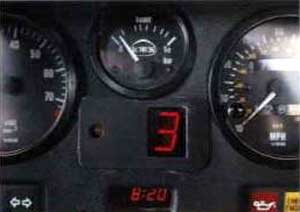
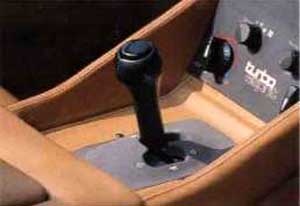
LED display indicates selected gear . . . . . . . . . . . .Three positions for Esprit 'gear lever'
Once on the move, you use the wheel-mounted buttons to change gear. Press either button facing you to go up through the gearbox, either button behind the wheel to go down. It is possible to use the lever up and downshifts, Tiptronic-style, but the Lotus-AP development engineers use it only for low-speed manoeuvring. There is no clutch pedal. Instead, at the appropriate times, the computers at the heart of the SMART system engage it, disengage it and match the ratios with the appropriate engine revs.
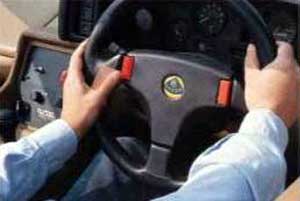
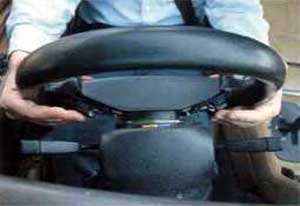
Two buttons at front for upchanges . . . . . . . . . . those behind for slotting down a gear
The upshot is that you get the gear you want, when you want it. You don't have to bother about moving your left (gearchange) arm and (clutch) leg while driving or worry about matching revs to a ratio on downchanges. The gearchanges themselves take only about 0.5secs, as fast as Lotus's test drivers can manage in conventional Esprits. SMART grew out of research programmes AP and Lotus already had under way before they became partners about two years ago. AP, the instigator, was already at work on an automatic clutch system which, incidently, will go into a volume European car later this year. Lotus, meanwhile, was undertaking research for a client (who eventually backed out) interested in an advanced transmission system. Encouraged by preliminary results, Lotus pressed ahead with what is called "very realistic computer simulations" which turned it's engineers away from CVTs (continuously variable transmissions of the kind that are used by the likes of Ford, Fiat and Subaru) towards so-called 'smart' transmissions - electronically controlled automatic gearboxes.
It seemed logical for the pair to pool their resources. Now a dozen engineers and technicians, drawn from both companies, are at work on the SMART project which uses Lotus's Hethel facility as its day-to-day headquarters. Eventually, AP hopes to sell SMART technology to major car manufacturers. And Lotus foresees a day when SMART will go into one of its own production models. What makes SMART work ? Electronic 'brains' usehydraulic and electric 'muscles' to do the work of the driver's left leg and left arm. The gearchange and clutch are worked by high-pressure hydraulics; an electric motor actuactes the throttle. The SMART system needs three large microprocessors - one for electronic accelerator, one for clutch/gearbox, one to provide ignition/engine managment and to link the whole system together. All three are mounted on a tray on the rear panel of the engine bay.
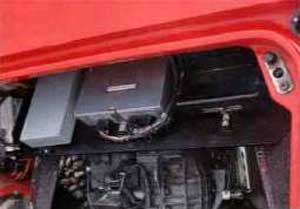
Three computers control the system . . . . . . . . . . . Always in right gear with semi-auto box
On the road, the system is convenience itself. Its best trick is the way it copes with coming to a halt in fifth gear: disengaging perfectly, then pulling away from a standstill, all the while in the top ratio. When we tried it, the engine chugged at 1600 to 1800rpm in fifth, computers slipping the clucth and juggling the throttle until the speed rose to about 30mph when the clutch could be fully engaged. It was hardly good driving but it proved the subtle control the microprocessors have over the car. When stationary, you merely press one of the downchange buttons twice and the 'box goes back to first, and the dash-mounted LED readout blinks to show '1' in confirmation.
The system is simplicity itself. After a minute or two, I
was click-clacking through the gears on the red buttonswith ease, amused by
the idea of using an office computer key to control the antics of a gearbox
and vary the note of the 16-valve Lotus twin-cam engine so smoothly.
It's best to ease the accelerator on upchanges, coming down needs no such
finesse. Hit the button fast enough, twice if you like, and this Esprit will
click from 100mph in fourth on arriving at a bend, to a suave 40mph in second
at the apex. You sweep out of the tightest corner in the right ratio, ready
to apply power just where it's needed. Even on this early experimental car,
it's clear that the SMART transmission has huge potential. It reduces the
stress of driving for two reasons: firstly, because you need not supply effort
to change gears; and secondly, because the computers release you from the
concentration of chasing the perfect gearchange. Best of all, it enhances
driving enjoyment. When can I buy one?
Change gear with red buttons on Lotus's wheel
|
|